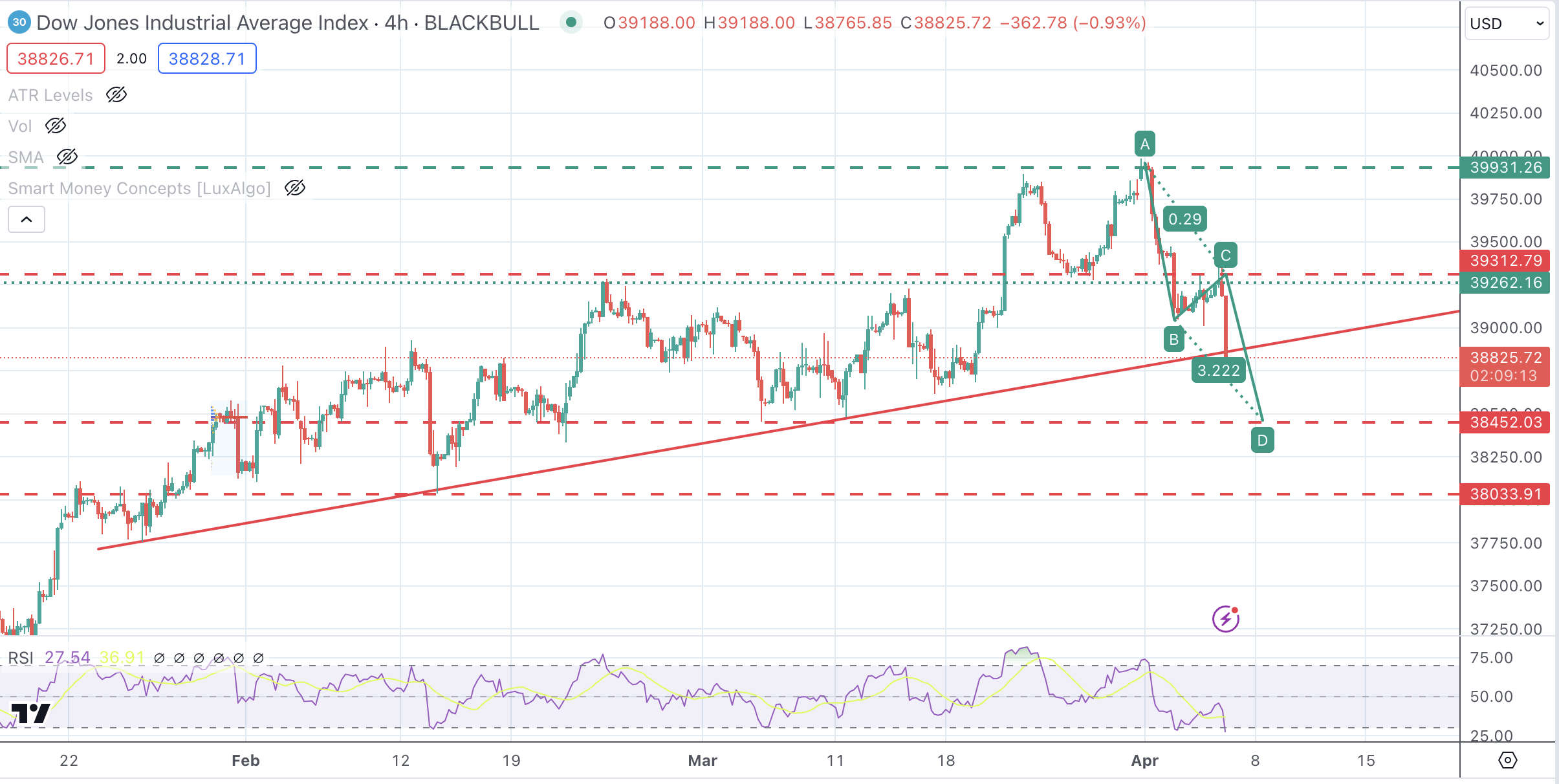Dow Jones Industrial Average drops to multi-day lows on dwindling rate cut bets
- Dow Jones posts a minor decline following a positive session as Fed officials cool hopes of immediate rate cuts.
- Fed Goldsbee and Kashkari ask for more time and hint towards less than three rate cuts in 2024.
- Earlier on Thursday, higher-than-expected US Jobless claims had boosted risk appetite,
The Dow Jones Industrial Average (DJIA) is nursing moderate losses after having turned down following a positive morning session. A string of Federal Reserve (Fed) officials hit the wires on Thursday, requesting more time to start cutting rates, offsetting the positive sentiment triggered by the soft employment data.
Chicago Fed President Austen Goldsbee has struck a hawkish tone, recalling that he anticipated two rate cuts this year before putting into question whether that bank should cut rates at all if inflation remains sticky. Later on, Minneapolis Fed CEO, Neel Kashkari has reiterated this view, suggesting that there might not be rate cuts if inflation stalls.
Before that, weekly applications for unemployment benefits rose to their highest level in two months in the last week of March, according to data released by the Labor Department. These figures came after the weak services sector activity data on Wednesday and boosted hopes that the Fed might stick to its plan of three rate cuts this year. In this context, the market will be especially attentive to Friday’s US Nonfarm Payrolls (NFP) report for more clues about the rate outlook.
All Wall Street indexes have turned negative with the Dow Jones, leading losses with a 0.6% decline to 38,2843, followed by the S&P 500, down 0.5% at 5,186, and the NASDAQ, which drops 0.2% to 16,239.
Dow Jones news
All the 11 Wall Street sectors have turned negative on Thursday's afternoon trading. Health is leading losses with a 0.8% decline, followed by Real Estate, 0.66% down, and the Financial sector, losing 0.55%.
Microsoft (MSFT) is the best performer of the Dow Jones Index, up 0.6%, to $422.04, followed by Travelers Companies (TRV) with a 0.33% advance to $229.71. 3M (MMM) is the biggest loser, declining 2.16% to $91.22. followed by Salesforce (CRM) 2.14% down to $298.20.
Dow Jones technical outlook
The pair is on a corrective reversal from the 40,000 psychological level, with bearish pressure gathering pace, as price action breached the trendline support from late-January lows, at 38,860. An AB=CD correction would target the early March lows at 38,452.
A bullish reaction, which would need from soft US Nonfarm Payrolls data would meet resistance at 39,312 ahead of the 40,000 historic high.
Dow Jones 4-Hour Chart

Dow Jones FAQs
The Dow Jones Industrial Average, one of the oldest stock market indices in the world, is compiled of the 30 most traded stocks in the US. The index is price-weighted rather than weighted by capitalization. It is calculated by summing the prices of the constituent stocks and dividing them by a factor, currently 0.152. The index was founded by Charles Dow, who also founded the Wall Street Journal. In later years it has been criticized for not being broadly representative enough because it only tracks 30 conglomerates, unlike broader indices such as the S&P 500.
Many different factors drive the Dow Jones Industrial Average (DJIA). The aggregate performance of the component companies revealed in quarterly company earnings reports is the main one. US and global macroeconomic data also contributes as it impacts on investor sentiment. The level of interest rates, set by the Federal Reserve (Fed), also influences the DJIA as it affects the cost of credit, on which many corporations are heavily reliant. Therefore, inflation can be a major driver as well as other metrics which impact the Fed decisions.
Dow Theory is a method for identifying the primary trend of the stock market developed by Charles Dow. A key step is to compare the direction of the Dow Jones Industrial Average (DJIA) and the Dow Jones Transportation Average (DJTA) and only follow trends where both are moving in the same direction. Volume is a confirmatory criteria. The theory uses elements of peak and trough analysis. Dow’s theory posits three trend phases: accumulation, when smart money starts buying or selling; public participation, when the wider public joins in; and distribution, when the smart money exits.
There are a number of ways to trade the DJIA. One is to use ETFs which allow investors to trade the DJIA as a single security, rather than having to buy shares in all 30 constituent companies. A leading example is the SPDR Dow Jones Industrial Average ETF (DIA). DJIA futures contracts enable traders to speculate on the future value of the index and Options provide the right, but not the obligation, to buy or sell the index at a predetermined price in the future. Mutual funds enable investors to buy a share of a diversified portfolio of DJIA stocks thus providing exposure to the overall index.